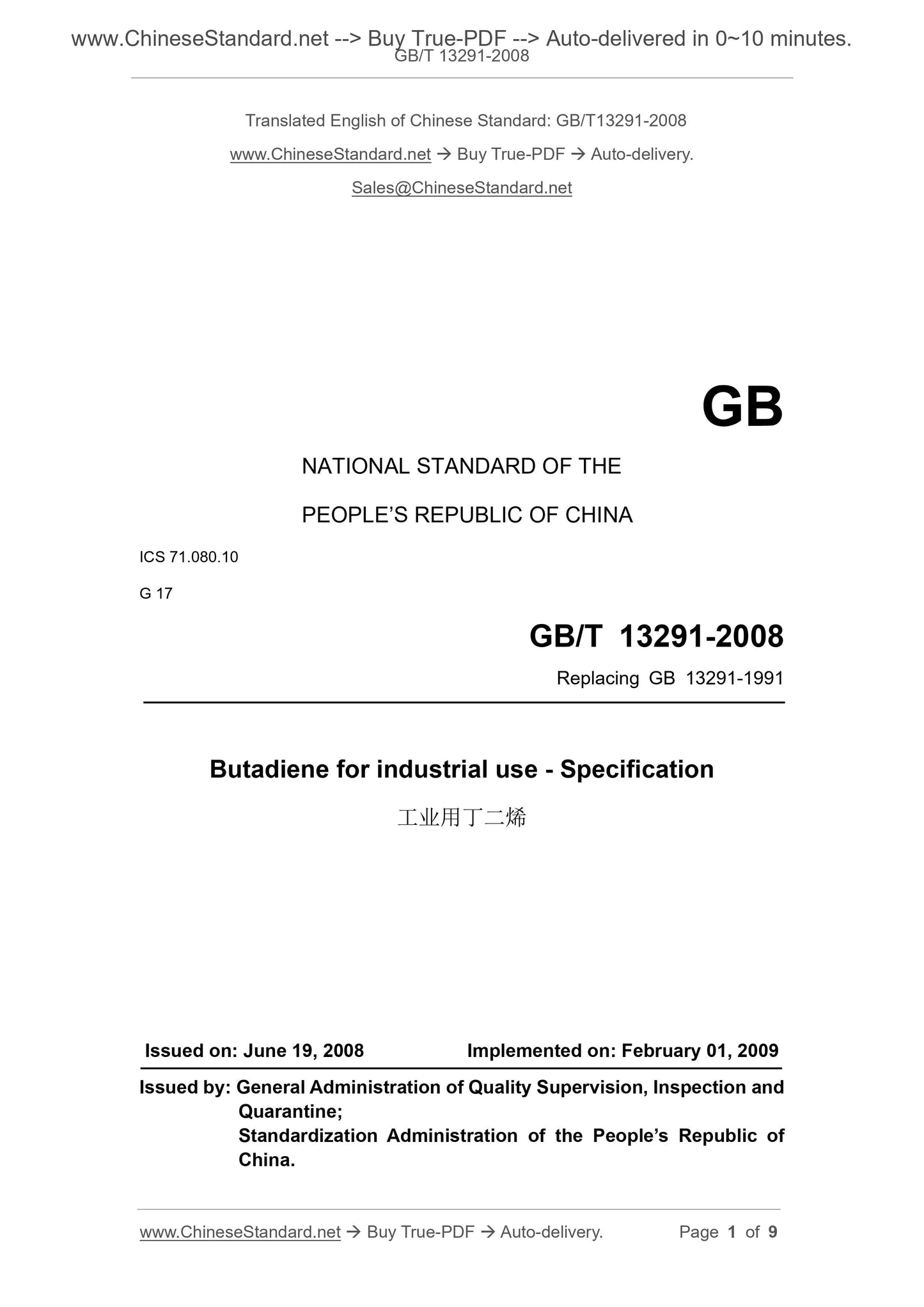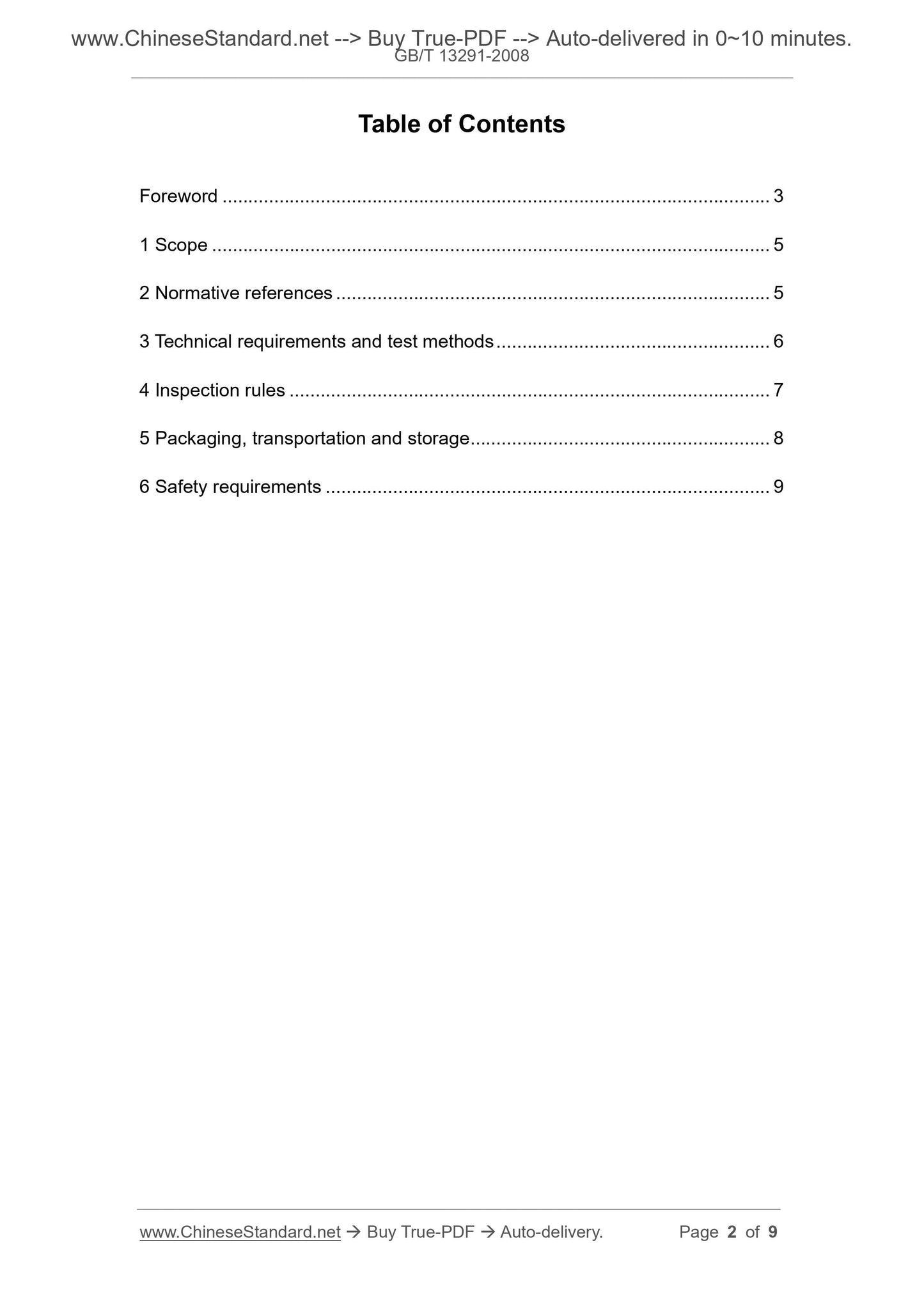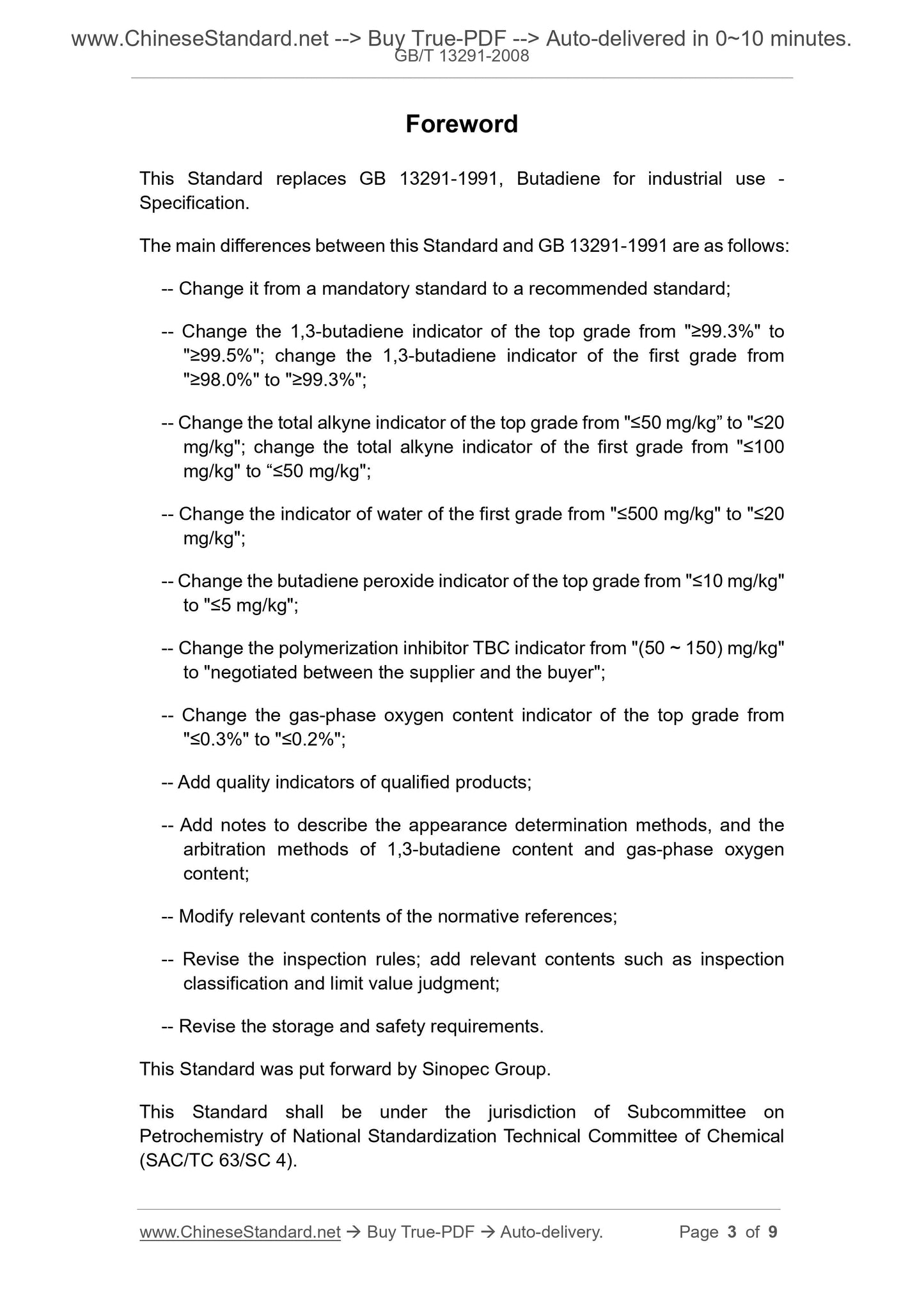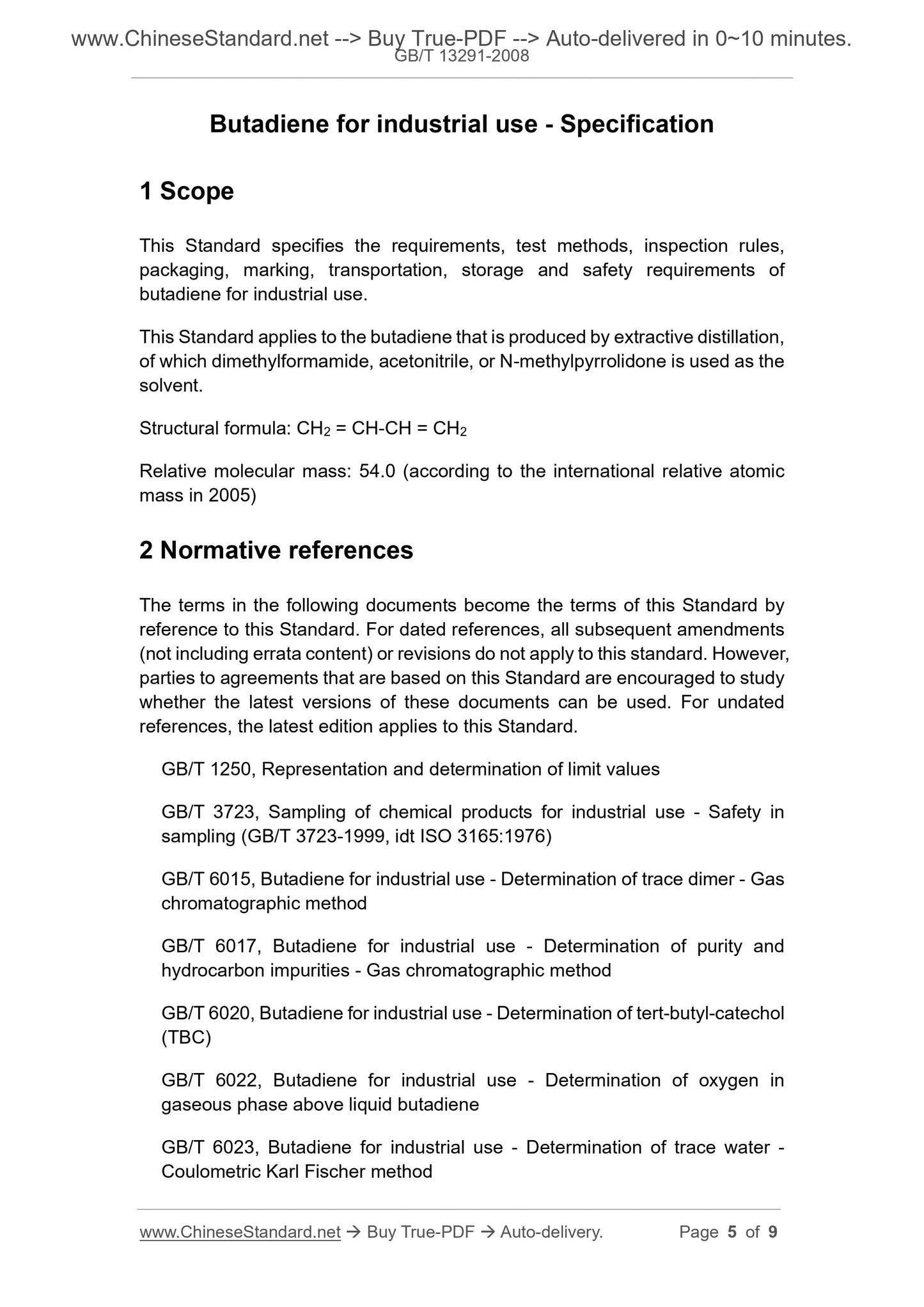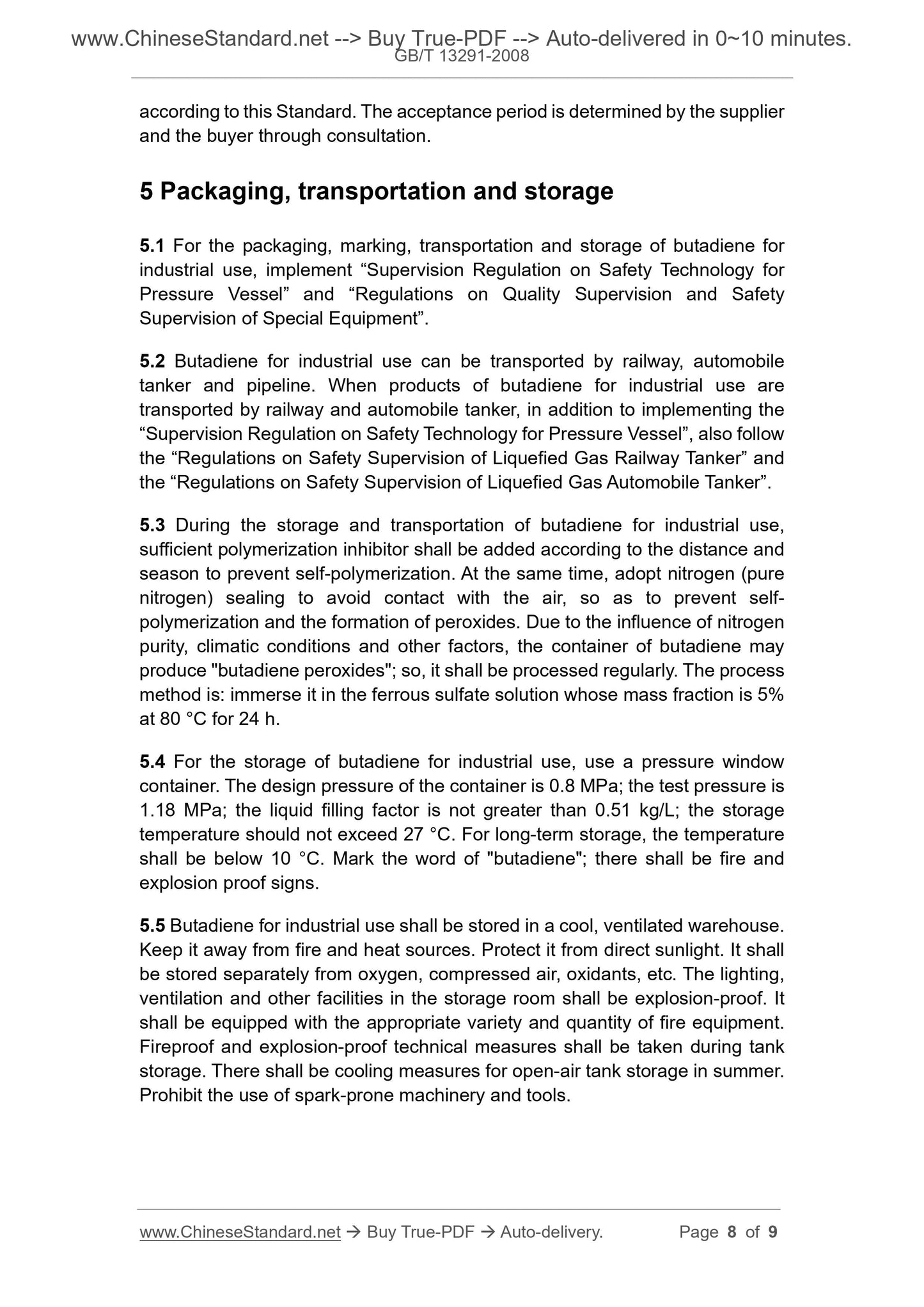1
/
of
5
PayPal, credit cards. Download editable-PDF and invoice in 1 second!
GB/T 13291-2008 English PDF (GBT13291-2008)
GB/T 13291-2008 English PDF (GBT13291-2008)
Regular price
$120.00 USD
Regular price
Sale price
$120.00 USD
Unit price
/
per
Shipping calculated at checkout.
Couldn't load pickup availability
Delivery: 3 seconds. Download true-PDF + Invoice.
Get QUOTATION in 1-minute: Click GB/T 13291-2008
Historical versions: GB/T 13291-2008
Preview True-PDF (Reload/Scroll if blank)
GB/T 13291-2008: Butadiene for industrial use-specification
GB/T 13291-2008
NATIONAL STANDARD OF THE
PEOPLE’S REPUBLIC OF CHINA
ICS 71.080.10
G 17
Replacing GB 13291-1991
Butadiene for industrial use - Specification
ISSUED ON: JUNE 19, 2008
IMPLEMENTED ON: FEBRUARY 01, 2009
Issued by: General Administration of Quality Supervision, Inspection and
Quarantine;
Standardization Administration of the People’s Republic of
China.
Table of Contents
Foreword ... 3
1 Scope ... 5
2 Normative references ... 5
3 Technical requirements and test methods ... 6
4 Inspection rules ... 7
5 Packaging, transportation and storage ... 8
6 Safety requirements ... 9
Foreword
This Standard replaces GB 13291-1991, Butadiene for industrial use -
Specification.
The main differences between this Standard and GB 13291-1991 are as follows:
-- Change it from a mandatory standard to a recommended standard;
-- Change the 1,3-butadiene indicator of the top grade from "≥99.3%" to
"≥99.5%"; change the 1,3-butadiene indicator of the first grade from
"≥98.0%" to "≥99.3%";
-- Change the total alkyne indicator of the top grade from "≤50 mg/kg” to "≤20
mg/kg"; change the total alkyne indicator of the first grade from "≤100
mg/kg" to “≤50 mg/kg";
-- Change the indicator of water of the first grade from "≤500 mg/kg" to "≤20
mg/kg";
-- Change the butadiene peroxide indicator of the top grade from "≤10 mg/kg"
to "≤5 mg/kg";
-- Change the polymerization inhibitor TBC indicator from "(50 ~ 150) mg/kg"
to "negotiated between the supplier and the buyer";
-- Change the gas-phase oxygen content indicator of the top grade from
"≤0.3%" to "≤0.2%";
-- Add quality indicators of qualified products;
-- Add notes to describe the appearance determination methods, and the
arbitration methods of 1,3-butadiene content and gas-phase oxygen
content;
-- Modify relevant contents of the normative references;
-- Revise the inspection rules; add relevant contents such as inspection
classification and limit value judgment;
-- Revise the storage and safety requirements.
This Standard was put forward by Sinopec Group.
This Standard shall be under the jurisdiction of Subcommittee on
Petrochemistry of National Standardization Technical Committee of Chemical
(SAC/TC 63/SC 4).
Butadiene for industrial use - Specification
1 Scope
This Standard specifies the requirements, test methods, inspection rules,
packaging, marking, transportation, storage and safety requirements of
butadiene for industrial use.
This Standard applies to the butadiene that is produced by extractive distillation,
of which dimethylformamide, acetonitrile, or N-methylpyrrolidone is used as the
solvent.
Structural formula: CH2 = CH-CH = CH2
Relative molecular mass: 54.0 (according to the international relative atomic
mass in 2005)
2 Normative references
The terms in the following documents become the terms of this Standard by
reference to this Standard. For dated references, all subsequent amendments
(not including errata content) or revisions do not apply to this standard. However,
parties to agreements that are based on this Standard are encouraged to study
whether the latest versions of these documents can be used. For undated
references, the latest edition applies to this Standard.
GB/T 1250, Representation and determination of limit values
GB/T 3723, Sampling of chemical products for industrial use - Safety in
sampling (GB/T 3723-1999, idt ISO 3165:1976)
GB/T 6015, Butadiene for industrial use - Determination of trace dimer - Gas
chromatographic method
GB/T 6017, Butadiene for industrial use - Determination of purity and
hydrocarbon impurities - Gas chromatographic method
GB/T 6020, Butadiene for industrial use - Determination of tert-butyl-catechol
(TBC)
GB/T 6022, Butadiene for industrial use - Determination of oxygen in
gaseous phase above liquid butadiene
GB/T 6023, Butadiene for industrial use - Determination of trace water -
Coulometric Karl Fischer method
according to this Standard. The acceptance period is determined by the supplier
and the buyer through consultation.
5 Packaging, transportation and storage
5.1 For the packaging, marking, transportation and storage of butadiene for
industrial use, implement “Supervision Regulation on Safety Technology for
Pressure Vessel” and “Regulations on Quality Supervision and Safety
Supervision of Special Equipment”.
5.2 Butadiene for industrial use can be transported by railway, automobile
tanker and pipeline. When products of butadiene for industrial use are
transported by railway and automobile tanker, in addition to implementing the
“Supervision Regulation on Safety Technology for Pressure Vessel”, also follow
the “Regulations on Safety Supervision of Liquefied Gas Railway Tanker” and
the “Regulations on Safety Supervision of Liquefied Gas Automobile Tanker”.
5.3 During the storage and transportation of butadiene for industrial use,
sufficient polymerization inhibitor shall be added according to the distance and
season to prevent self-polymerization. At the same time, adopt nitrogen (pure
nitrogen) sealing to avoid contact with the air, so as to prevent self-
polymerization and the formation of peroxides. Due to the influence of nitrogen
purity, climatic conditions and other factors, the container of butadiene may
produce "butadiene peroxides"; so, it shall be processed regularly. The process
method is: immerse it in the ferrous sulfate solution whose mass fraction is 5%
at 80 °C for 24 h.
5.4 For the storage of butadiene for industrial use, use a pressure window
container. The design pressure of the container is 0.8 MPa; the test pressure is
1.18 MPa; the liquid filling factor is not greater than 0.51 kg/L; the storage
temperature should not exceed 27 °C. For long-term storage, the temperature
shall be below 10 °C. Mark the word of "butadiene"; there shall be fire and
explosion proof signs.
5.5 Butadiene for industrial use shall be stored in a cool, ventilated warehouse.
Keep it away from fire and heat sources. Protect it from direct sunlight. It shall
be stored separately from oxygen, compressed air, oxidants, etc. The lighting,
ventilation and other facilities in the storage room shall be explosion-proof. It
shall be equipped with the appropriate variety and quantity of fire equipment.
Fireproof and explosion-proof technical measures shall be taken during tank
storage. There shall be cooling measures for open-air tank storage in summer.
Prohibit the use of spark-prone machinery and tools.
Get QUOTATION in 1-minute: Click GB/T 13291-2008
Historical versions: GB/T 13291-2008
Preview True-PDF (Reload/Scroll if blank)
GB/T 13291-2008: Butadiene for industrial use-specification
GB/T 13291-2008
NATIONAL STANDARD OF THE
PEOPLE’S REPUBLIC OF CHINA
ICS 71.080.10
G 17
Replacing GB 13291-1991
Butadiene for industrial use - Specification
ISSUED ON: JUNE 19, 2008
IMPLEMENTED ON: FEBRUARY 01, 2009
Issued by: General Administration of Quality Supervision, Inspection and
Quarantine;
Standardization Administration of the People’s Republic of
China.
Table of Contents
Foreword ... 3
1 Scope ... 5
2 Normative references ... 5
3 Technical requirements and test methods ... 6
4 Inspection rules ... 7
5 Packaging, transportation and storage ... 8
6 Safety requirements ... 9
Foreword
This Standard replaces GB 13291-1991, Butadiene for industrial use -
Specification.
The main differences between this Standard and GB 13291-1991 are as follows:
-- Change it from a mandatory standard to a recommended standard;
-- Change the 1,3-butadiene indicator of the top grade from "≥99.3%" to
"≥99.5%"; change the 1,3-butadiene indicator of the first grade from
"≥98.0%" to "≥99.3%";
-- Change the total alkyne indicator of the top grade from "≤50 mg/kg” to "≤20
mg/kg"; change the total alkyne indicator of the first grade from "≤100
mg/kg" to “≤50 mg/kg";
-- Change the indicator of water of the first grade from "≤500 mg/kg" to "≤20
mg/kg";
-- Change the butadiene peroxide indicator of the top grade from "≤10 mg/kg"
to "≤5 mg/kg";
-- Change the polymerization inhibitor TBC indicator from "(50 ~ 150) mg/kg"
to "negotiated between the supplier and the buyer";
-- Change the gas-phase oxygen content indicator of the top grade from
"≤0.3%" to "≤0.2%";
-- Add quality indicators of qualified products;
-- Add notes to describe the appearance determination methods, and the
arbitration methods of 1,3-butadiene content and gas-phase oxygen
content;
-- Modify relevant contents of the normative references;
-- Revise the inspection rules; add relevant contents such as inspection
classification and limit value judgment;
-- Revise the storage and safety requirements.
This Standard was put forward by Sinopec Group.
This Standard shall be under the jurisdiction of Subcommittee on
Petrochemistry of National Standardization Technical Committee of Chemical
(SAC/TC 63/SC 4).
Butadiene for industrial use - Specification
1 Scope
This Standard specifies the requirements, test methods, inspection rules,
packaging, marking, transportation, storage and safety requirements of
butadiene for industrial use.
This Standard applies to the butadiene that is produced by extractive distillation,
of which dimethylformamide, acetonitrile, or N-methylpyrrolidone is used as the
solvent.
Structural formula: CH2 = CH-CH = CH2
Relative molecular mass: 54.0 (according to the international relative atomic
mass in 2005)
2 Normative references
The terms in the following documents become the terms of this Standard by
reference to this Standard. For dated references, all subsequent amendments
(not including errata content) or revisions do not apply to this standard. However,
parties to agreements that are based on this Standard are encouraged to study
whether the latest versions of these documents can be used. For undated
references, the latest edition applies to this Standard.
GB/T 1250, Representation and determination of limit values
GB/T 3723, Sampling of chemical products for industrial use - Safety in
sampling (GB/T 3723-1999, idt ISO 3165:1976)
GB/T 6015, Butadiene for industrial use - Determination of trace dimer - Gas
chromatographic method
GB/T 6017, Butadiene for industrial use - Determination of purity and
hydrocarbon impurities - Gas chromatographic method
GB/T 6020, Butadiene for industrial use - Determination of tert-butyl-catechol
(TBC)
GB/T 6022, Butadiene for industrial use - Determination of oxygen in
gaseous phase above liquid butadiene
GB/T 6023, Butadiene for industrial use - Determination of trace water -
Coulometric Karl Fischer method
according to this Standard. The acceptance period is determined by the supplier
and the buyer through consultation.
5 Packaging, transportation and storage
5.1 For the packaging, marking, transportation and storage of butadiene for
industrial use, implement “Supervision Regulation on Safety Technology for
Pressure Vessel” and “Regulations on Quality Supervision and Safety
Supervision of Special Equipment”.
5.2 Butadiene for industrial use can be transported by railway, automobile
tanker and pipeline. When products of butadiene for industrial use are
transported by railway and automobile tanker, in addition to implementing the
“Supervision Regulation on Safety Technology for Pressure Vessel”, also follow
the “Regulations on Safety Supervision of Liquefied Gas Railway Tanker” and
the “Regulations on Safety Supervision of Liquefied Gas Automobile Tanker”.
5.3 During the storage and transportation of butadiene for industrial use,
sufficient polymerization inhibitor shall be added according to the distance and
season to prevent self-polymerization. At the same time, adopt nitrogen (pure
nitrogen) sealing to avoid contact with the air, so as to prevent self-
polymerization and the formation of peroxides. Due to the influence of nitrogen
purity, climatic conditions and other factors, the container of butadiene may
produce "butadiene peroxides"; so, it shall be processed regularly. The process
method is: immerse it in the ferrous sulfate solution whose mass fraction is 5%
at 80 °C for 24 h.
5.4 For the storage of butadiene for industrial use, use a pressure window
container. The design pressure of the container is 0.8 MPa; the test pressure is
1.18 MPa; the liquid filling factor is not greater than 0.51 kg/L; the storage
temperature should not exceed 27 °C. For long-term storage, the temperature
shall be below 10 °C. Mark the word of "butadiene"; there shall be fire and
explosion proof signs.
5.5 Butadiene for industrial use shall be stored in a cool, ventilated warehouse.
Keep it away from fire and heat sources. Protect it from direct sunlight. It shall
be stored separately from oxygen, compressed air, oxidants, etc. The lighting,
ventilation and other facilities in the storage room shall be explosion-proof. It
shall be equipped with the appropriate variety and quantity of fire equipment.
Fireproof and explosion-proof technical measures shall be taken during tank
storage. There shall be cooling measures for open-air tank storage in summer.
Prohibit the use of spark-prone machinery and tools.
Share
